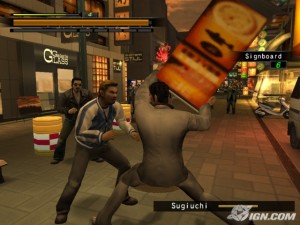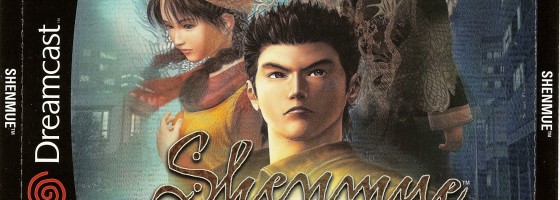In an earlier look at Sega’s exit from the console market I touched on how much was riding on the success of the Dreamcast. Specifically on Shenmue, that Sega hoped was their ace in the hole.
The backing that Sega gave for Shenmue was unprecedented at the time: Developed by Yu Suzuki who was one of Sega’s top developers, a planned trilogy and a cost of 47 million dollars to make. Shenmue’s commercial failure was one of the nails in the coffin for the Dreamcast. This is a shame as to me; it still is one of the finest games I’ve played.
One of the first 3D Console Worlds to Explore:
Shenmue is a tough game to classify and has become one of Sega’s most polarizing titles. It was released in the US in 2000, a year before Grand Theft Auto 3 ignited the open world genre. Shenmue’s game play is open world, but has more adventure and fighting game elements in it compared to other games in the genre.
The story is that the player is Ryo Hazuki in 1986 Japan. When he comes home one day to find a man from his father’s past takes a mysterious object from their house and kills Ryo’s father. As the beginning chapter of what was supposed to be a trilogy, Shenmue 1 follows Ryo uncovering the basic plot of who the man was that killed his father and where the next piece of the tale will take him.
While the game was considered open world, Shenmue’s game space was small compared to what other open world games would achieve. There are only a few areas consisting of Ryo’s house and the neighboring areas to explore. But what Shenmue’s environments lacked in quantity, they made up for with quality.
A Day In the life:
Of all the open world games I’ve played since Shenmue, it’s the only game that really felt like you were in the world. You could explore Ryo’s house, talk to people on the street, and even buy food and toys. Granted none of that had any in game affects, but it helped pull you into the world. Contrast that to today where most open world games feel soulless, as the player just blazes through the environment as fast as they can to reach the next mission point.
The heart of Shenmue’s gameplay would be in the adventure genre. As Ryo, the player had to uncover who the man was that killed his father, will take him across the neighborhood looking for clues. At certain points Ryo will have to fight, either one on one or against a group. At that point, the game transitions into a basic fighter, as Ryo is armed with a variety of attacks, with more that can be unlocked by finding training scrolls around the area.
The other part of the game play was the Quick Time Events. Yes, love them or hate them, Shenmue was the game that reintroduced them to modern gamers. If the player failed a QTE the scene would either progress from that point, or be reset to give the player a second chance.
In the end, Shenmue didn’t exactly flop, but didn’t earn enough money to continue development of the series and the Dreamcast. As I mentioned at the start, the game was a polarizing experience and the main reason for that was the pacing. Shenmue was a slow game, with major plot points only occurring few and far between. The rest of the game was about the player living Ryo’s daily life and uncovering clues bit by bit.

The Yakuza series, featured a similar combination of exploration and combat and is the closest to emulating Shenmue’s style.
One section near the end had the player get a part time job as a forklift driver at the docks, which the player had to do every day of in game time until the next plot point revealed itself.
I found this to be an interesting change of pace, but for gamers looking for action, that must have been torture. The game’s most intense section occurred near the end with a one against 100 fight as Ryo took on an entire gang of thugs.
The problem was how Shenmue was designed differently from other games. The thing about Shenmue was that it wasn’t designed as a standalone game, but from day one was planned around a three game trilogy.
“Contrast that to today where most open world games feel soulless, as the player just blazes through the environment as fast as they can to reach the next mission point.”
Most game series are built around standalone titles with either a loose thread between them, or a constant theme that defines the series. Very few games are designed with a set # of titles in mind, as neither the publisher nor the designer knows if the series will be a hit.
Shenmue was supposed to be slow pace as it was the first chapter of the trilogy, similar to the first movie of The Lord of The Rings. This was the chapter that would set up the situation and get the player ready for what’s to come.
The Missed Sequel:
And what did come, most people did not play until it was too late. Shenmue 2 was released on the Dreamcast in Japan and Europe and was eventually ported to the Xbox. Shenmue 2 improved on the first one in every way: bigger environments, more things to do, more fighting, and more events to the story. I wonder how much of a difference it would have made if Shenmue 2 came out in the US as the first game instead of Shenmue 1, as it’s that much of an improvement.
The Shenmue torch has been kept alive by fans, with many of them still wanting Yu Suzuki to finish the trilogy. The Yakuza series draws similarities to Shenmue, but its more focus on action as opposed to the multi-game story that Shenmue was supposed to have.
Shenmue’s fate is really a shame both for Sega and the industry. Long before Bioware developed the Mass Effect series as a three game trilogy, Shenmue would have beaten them to the punch. Sometimes it’s not the first attempt at something new that gets the praise, but the second that refined and became the standard instead. This is one of the ways how Grand Theft Auto 3 became the poster child for the open world sand box genre.
Shenmue is sadly one of many unfinished projects in the industry and whether or not we will see a conclusion is anyone’s guess.


Pingback: Adventure Games Aren’t Dead Yet « Snacked Up()